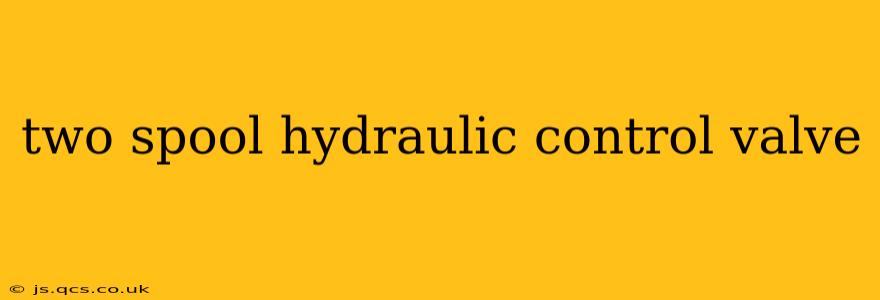Hydraulic systems are the backbone of countless industrial applications, from heavy machinery to precision manufacturing. At the heart of many of these systems lie hydraulic control valves, and among them, the two-spool valve stands out for its versatility and efficiency. This detailed guide explores the functionality, applications, and key considerations surrounding two-spool hydraulic control valves.
What is a Two-Spool Hydraulic Control Valve?
A two-spool hydraulic control valve is a type of directional control valve that utilizes two independent spools to manage the flow of hydraulic fluid in a system. Each spool controls a separate hydraulic circuit, allowing for independent control of two actuators or functions. This contrasts with single-spool valves, which control only one circuit at a time. The independent control offered by a two-spool valve significantly enhances the flexibility and complexity of operations possible within a hydraulic system. The spools can be actuated either manually (lever-operated) or electrically (solenoid-operated), depending on the specific design and application needs.
How Does a Two-Spool Hydraulic Control Valve Work?
The operation hinges on the positioning of the two spools. Each spool possesses several positions, typically including a neutral position (blocking flow), and positions allowing flow in one or both directions. These positions are strategically determined by the valve's design and the specific application requirements. For instance, one spool might control the extension of a hydraulic cylinder, while the other controls its retraction. Simultaneous operation of both spools allows for coordinated movement or independent operations of the connected actuators.
The precision and control offered by a two-spool valve are substantial, especially when compared to simpler valve systems. This precision is crucial in applications that require finely tuned hydraulic movements.
What are the Different Types of Two-Spool Hydraulic Control Valves?
Several variations exist, categorized based on factors like spool actuation, flow control features, and specific circuit configurations. Common types include:
- Manually Operated Valves: These valves use levers or handles to shift the spools, offering a simple and direct method of control. They're often found in smaller or less complex systems.
- Solenoid Operated Valves: These valves use electromagnets to shift the spools, allowing for remote and automated control. This enables sophisticated control systems and integration with programmable logic controllers (PLCs).
- Two-Spool, Four-Way Valves: A prevalent configuration providing flow control in two separate circuits, each with the ability to send hydraulic fluid in both directions (forward and reverse). This enables bidirectional control of two actuators.
- Two-Spool Valves with Flow Control: These incorporate flow control mechanisms (like metering orifices) to adjust the speed of actuation in each circuit.
What are the advantages of using a two-spool valve?
- Independent Control of Multiple Circuits: This is the primary advantage. The system gains greater flexibility, enabling more complex operations.
- Increased Efficiency: By independently controlling multiple functions, the system avoids the need for multiple single-spool valves, simplifying the setup and potentially reducing cost and complexity.
- Enhanced Precision: The independent control allows for more precise coordination of movements, particularly important in tasks requiring delicate adjustments.
- Versatility: Adaptable to a broad range of hydraulic systems and applications.
What are the disadvantages of using a two-spool valve?
- Increased Complexity: Compared to single-spool valves, they are more intricate, leading to potentially higher maintenance requirements.
- Higher Cost: Generally, they are more expensive than simpler single-spool alternatives.
- Larger Size: They often occupy more space than single-spool valves, an important consideration for compact systems.
What are some common applications of two-spool hydraulic control valves?
Two-spool valves find their place in numerous applications, including:
- Construction Equipment: Controlling movements of multiple hydraulic cylinders in excavators, loaders, and other heavy machinery.
- Agricultural Machinery: Managing the operation of implements like hydraulic lifts and implements.
- Manufacturing Systems: Precisely controlling robotic arms, automated assembly lines, and other automated processes.
- Material Handling Equipment: Coordinating the movement of forklifts and other handling equipment.
- Mobile Hydraulic Systems: Used in various mobile applications, like cranes and specialized vehicles.
How do I choose the right two-spool hydraulic control valve for my application?
Selecting the appropriate valve requires careful consideration of various factors:
- Flow Rate: The required flow rate of hydraulic fluid for each circuit.
- Operating Pressure: The maximum operating pressure of the system.
- Type of Actuation: Manual or solenoid-operated.
- Number of Ports: Determine the number of ports needed based on the system's circuit configuration.
- Flow Control Features: Decide if flow control is necessary for each circuit.
- Mounting Style: The mounting style compatible with your system.
Selecting the right two-spool hydraulic control valve is crucial for optimal system performance and reliability. Understanding its functionality, different types, and application considerations ensures informed decision-making for any hydraulic system design. Always consult with a hydraulics specialist for complex applications or when uncertain about the optimal valve selection for your specific needs.
